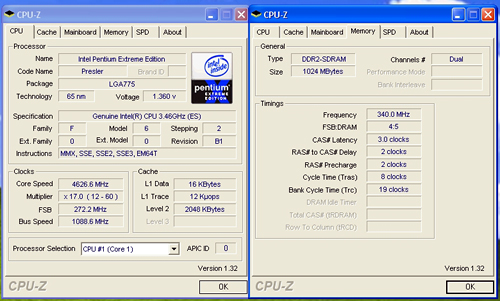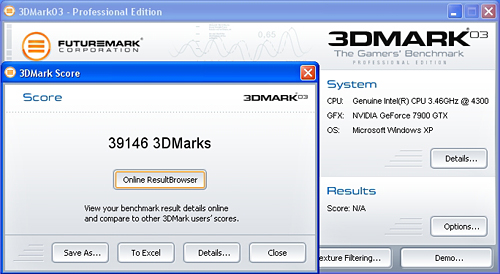NVIDIA nForce4 SLI XE: Enthusiast Features on a Budget
by Gary Key on March 23, 2006 12:05 AM EST- Posted in
- Motherboards
FSB Overclocking Results
This board is a competitve overclocker when comparing it to the Intel 975X boards for maximum CPU speeds, but it still trails the 975X boards in FSB speeds as our Asus and Gigabyte boards can reach a 340FSB level for performance testing although their application stable FSB levels are slightly above 300. At these settings, the system is able to complete all of our benchmark test suites three consecutive times along with SuperPI and run Prime95 for a minimum of four hours. We lowered the CPU multiplier to 14, but it could not overclock past a 268FSB setting with our test CPU. We changed the LDT ratio to several different settings without success. These results continue the pattern that we see in the nForce4 Intel Edition chipsets not reaching high FSB speeds, yet being very successful in overclocking the CPU at standard FSB settings.
Memory Stress Testing
This memory stress test looks at the ability of the ECS C19-A SLI to operate at the officially supported memory frequencies of 533MHz DDR2, at the best performing memory timings that the Corsair CM2X512A-5400UL revision 1.3 will support. Note that this memory is rated at 3-2-2-8 timings for 667MHz operation.
The ECS C19-A SLI was very stable with 2 DDR2 modules in Dual-Channel at the settings of 3-2-2-8 at 2.1V. We will now install all four available memory slots that result in more strenuous requirements on the memory subsystem than testing 2 DDR2 modules on a motherboard.
The ECS C19-A SLI was completely stable with 4 DDR2 modules in Dual-Channel operation at the settings of 3-3-3-8, but it required the command rate to be increased to 2T.
| Front Side Bus Overclocking Testbed | |
| Processor: | Pentium 4 Smithfield LGA 775 840EE Dual Core 3.2GHz |
| CPU Voltage: | 1.4750V (1.4000V default) |
| Memory Settings: | 3-2-2-8 at 667MHz |
| Memory Voltage: | 2.2V |
| SPP Voltage: | Default |
| FSB Voltage: | Default |
| Cooling: | Zalman CNPS 9500 |
| Power Supply: | PC Power and Cooling 850 SSI |
| Maximum CPU OverClock: | 254fsb x 17 (4318MHz) +35% |
| Maximum FSB OverClock: | 268fsb x 16 (4288MHz) +34% |
This board is a competitve overclocker when comparing it to the Intel 975X boards for maximum CPU speeds, but it still trails the 975X boards in FSB speeds as our Asus and Gigabyte boards can reach a 340FSB level for performance testing although their application stable FSB levels are slightly above 300. At these settings, the system is able to complete all of our benchmark test suites three consecutive times along with SuperPI and run Prime95 for a minimum of four hours. We lowered the CPU multiplier to 14, but it could not overclock past a 268FSB setting with our test CPU. We changed the LDT ratio to several different settings without success. These results continue the pattern that we see in the nForce4 Intel Edition chipsets not reaching high FSB speeds, yet being very successful in overclocking the CPU at standard FSB settings.


Memory Stress Testing
This memory stress test looks at the ability of the ECS C19-A SLI to operate at the officially supported memory frequencies of 533MHz DDR2, at the best performing memory timings that the Corsair CM2X512A-5400UL revision 1.3 will support. Note that this memory is rated at 3-2-2-8 timings for 667MHz operation.
| ECS C19-A SLI Stable DDR2-667 Timings - 2 DIMMs (2/4 slots populated - 1 Dual-Channel Bank) |
|
| Clock Speed: | 200MHz (800FSB) |
| Timing Mode: | 667MHz - Default |
| CAS Latency: | 3 |
| RAS to CAS Delay: | 2 |
| RAS Precharge: | 2 |
| RAS Cycle Time: | 8 |
| Command Rate: | 1T |
| Voltage: | 2.1V |
The ECS C19-A SLI was very stable with 2 DDR2 modules in Dual-Channel at the settings of 3-2-2-8 at 2.1V. We will now install all four available memory slots that result in more strenuous requirements on the memory subsystem than testing 2 DDR2 modules on a motherboard.
| ECS C19-A SLI Stable DDR2-667 Timings - 4 DIMMs (4/4 slots populated - 2 Dual-Channel Banks) |
|
| Clock Speed: | 200MHz (800FSB) |
| Timing Mode: | 667MHz - Default |
| CAS Latency: | 3 |
| RAS to CAS Delay: | 3 |
| RAS Precharge: | 3 |
| RAS Cycle Time: | 8 |
| Command Rate: | 2T |
| Voltage: | 2.1V |
The ECS C19-A SLI was completely stable with 4 DDR2 modules in Dual-Channel operation at the settings of 3-3-3-8, but it required the command rate to be increased to 2T.










12 Comments
View All Comments
mindless1 - Saturday, March 25, 2006 - link
Well, you could just tell us. Previously ECS used a lot of OST caps but these may be Panasonic FM? (at least some, the 10mm x 25(?)mm look like it in the VRM. More significant might be the lack of capacitors for memory, could be part of why the board is a bit fickle about o'c.Per Hansson - Saturday, March 25, 2006 - link
Sounds very good Gary ;-)